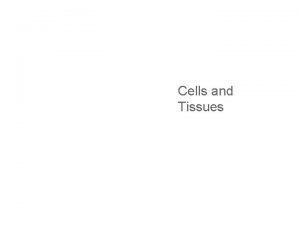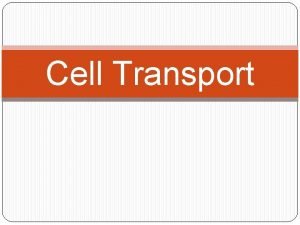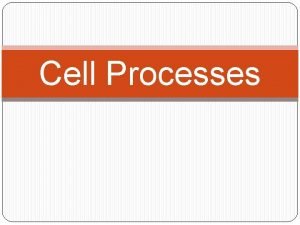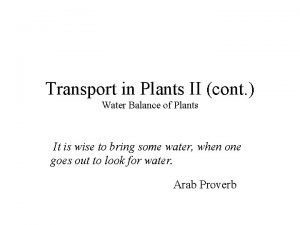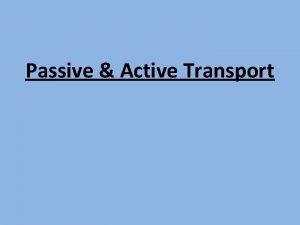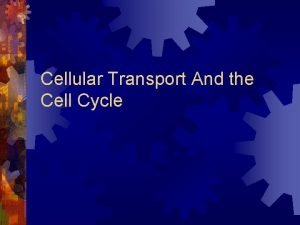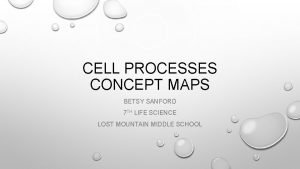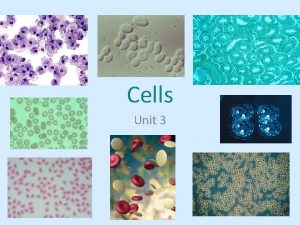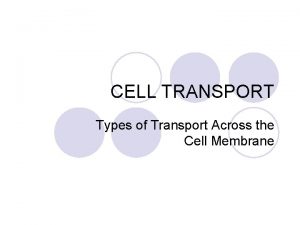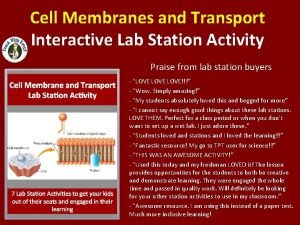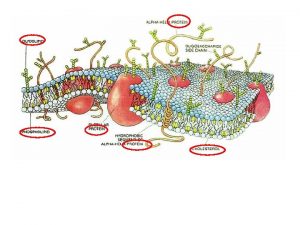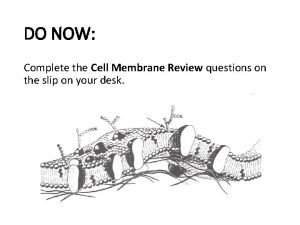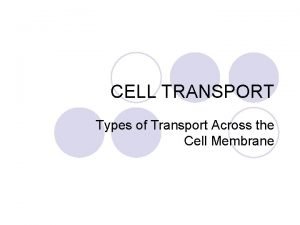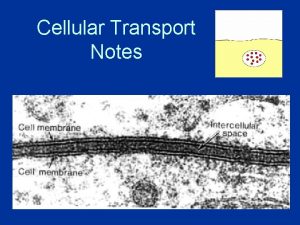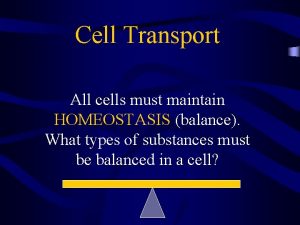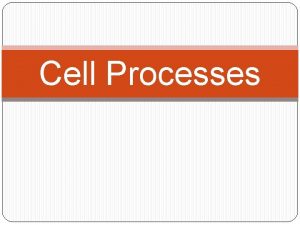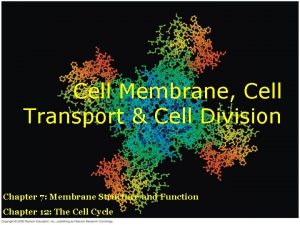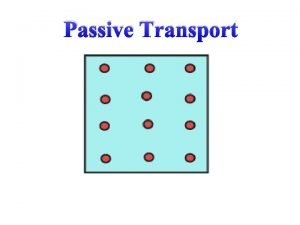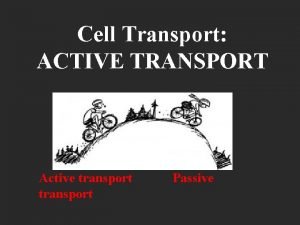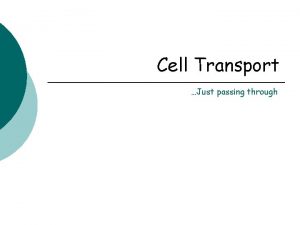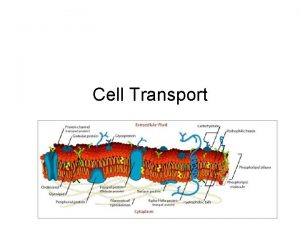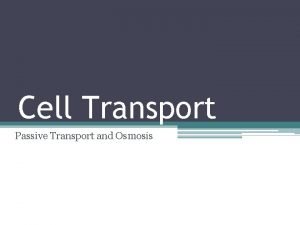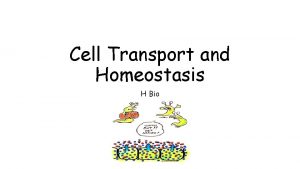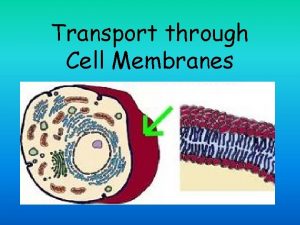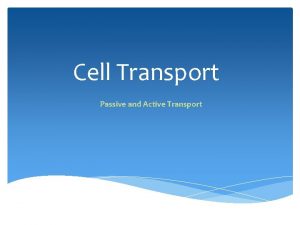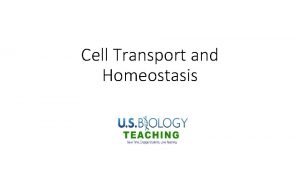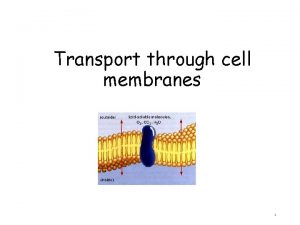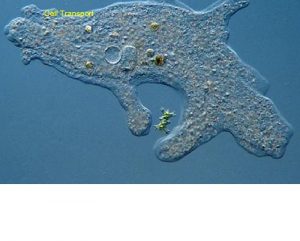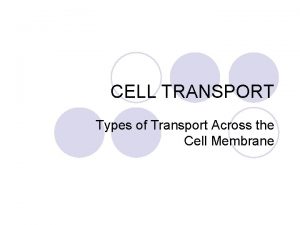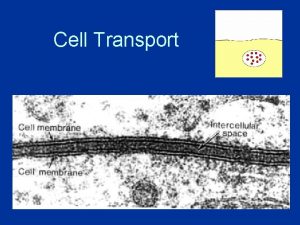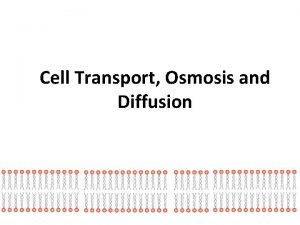Chapter 7 3 Cell Transport CELL TRANSPORT What

































- Slides: 33

Chapter 7. 3 Cell Transport CELL TRANSPORT What is it?

Cell Transport DEFINITION: • Cell Transport is moving materials into, out of, or within the cell

What is the purpose of Cell Transport? • Cells need to bring in materials necessary for homeostasis. • Cells need to get rid of wastes • Cells produce materials that will be used in other parts of the cell, or outside the cell in other parts of the organism

THE CELL MEMBRANE REVIEW STRUCTURE • The cell membrane is composed of two layers phospholipids of _______. • It is called the aqueous environment phospholipid bilayer _________ because it is made of these two layers. aqueous environment phosphate head fatty acid tails

THE CELL MEMBRANE REVIEW FUNCTION The cell membrane has several important functions: 1) It forms a physical barrier ______ to protect the inside of the cell from the outside environment. 2) It controls the transport ____ of substances into and out of the cell. This is possible because the membrane is semi-permeable _______ meaning only certain substances are allowed to cross it. 3) It plays a role in cell-to-cell communication _______.

Cell Membrane (Transport) Protein Channel Layer 1 Cell Membrane Layer 2 Lipid Bilayer Protein Pump

CELL TRANSPORT TYPES There are 2 types of Cell Transport: 1) The first type requiring No energy is ________ Passive Transport. 2) The second type Requiring the cell to expend energy is Active Transport. ________

CELL TRANSPORT PASSIVE Transport is a process that does NOT require energy to HIGH to LO Concentration. move molecules from a ______ 1) One type of passive transport includes _____ Diffusion. • A special type of diffusion involving the movement of water is _____ Osmosis. 2) A second type of passive transport that involves the use of protein channels is Facilitated Diffusion __________.

CELL TRANSPORT PASSIVE DIFFUSION is the movement of ______ Small particles across a semi permeable membrane, until ______ Equilibrium is reached. HIGH to LO concentration. These particle move from a ______ Outside of cell Inside of cell

DIFFUSION

DIFFUSION HIGH to LOW concentration

LINK Diffusion: http: //bcs. whfreeman. com/thelifewire/content/chp 05/0502001. html

CELL TRANSPORT PASSIVE OSMOSIS is the “diffusion” of ______ Water particles across a semi permeable membrane. HIGH to LO concentration These particle move from a ______ of water. The selectively permeable membrane is permeable to the small water molecules but not the larger sugar molecules

Water will travel to the Hypertonic side LINK Amoeba Sistiers Osmosis: https: //www. youtube. com/watch? v=Ia. Z 8 Mt. F 3 C 6 M

CELL TRANSPORT PASSIVE FACILITATED DIFFUSION is the movement of _______ Larger molecules across a semi permeable membrane. Larger molecules must be helped. Proteins in the cell membrane form ______ Channels for large molecules to pass through. Proteins that form channels for large molecule to pass through are called ________ Protein Channels. outside of cell inside of cell Glucose molecules

CELL TRANSPORT PASSIVE DIFFUSION vs. FACILITATED DIFFUSION Diffusion ______ Facilitated Diffusion _________ LINK: http: //bcs. whfreeman. com/thelifewire/content/chp 05/0502001. html

CELL TRANSPORT PASSIVE A solution, compared to the concentration inside a cell, maybe one of the following: 1) ______ Hypertonic compared to the inside of the cell. 2) ______ Hypotonic compared to the inside of the cell. 3) ______ Isotonic compared to the inside of the cell.

Hypertonic Solutions: contain a high concentration of solute relative to another solution (e. g. the cell's cytoplasm). When a cell is placed in a hypertonic solution, the water diffuses out of the cell, causing the cell to shrivel. Hypotonic Solutions: contain a low concentration of solute relative to another solution (e. g. the cell's cytoplasm). When a cell is placed in a hypotonic solution, the water diffuses into the cell, causing the cell to swell and possibly explode. Isotonic Solutions: contain the same concentration of solute as another solution (e. g. the cell's cytoplasm). When a cell is placed in an isotonic solution, the water diffuses into and out of the cell at the same rate. The fluid that surrounds the body cells is isotonic.


Isotonic Solution (Red Blood Cells) A solution is isotonic to a cell if it has the same concentration of solutes as the cell. Equal amounts of water enter and exit the cell, so its size stays constant.

Hypotonic Solution (Red Blood Cells) A hypotonic solution has fewer solutes than a cell. Overall, more water enters a cell in a hypotonic solution, causing the cell to expand even burst.

Hypertonic Solution (Red Blood Cells) A hypertonic solution has more solutes than a cell. Overall, more water exits a cell in a hypertonic solution, causing the cell to shrivel and even die

If the solution outside the cell is hypotonic, then inside the cell is hypertonic and vice versa Water tends to diffuse from hypotonic to hypertonic

CELL TRANSPORT The shrinking of cells when turgor pressure is lost is called ______ Plasmolysis. This is the reason plants ______ Wilt. PASSIVE


CELL TRANSPORT ACTIVE Transport is a process that DOES require energy to LO to HIGH Concentration. move molecules from a ______ Energy is _____ Required as molecules must be _______ Pumped Against the concentration gradient. Proteins that work as pumps are called _______. Protein Pumps outside of cell inside of cell Carbon Dioxide molecules


ANALOGY: ENERGY NEEDED: NO ENERGY NEEDED: 1) Diffusion (Passive Transport) 2) Facilitated Diffusion (Passive Transport) • Osmosis (type of diffusion involving water) 1) Active Transport


CELL TRANSPORT ACTIVE There are 2 special kinds of Active Transport for the Bulk Transport of larger molecules. ________ 1) ______ Endocytosis is the process by which cells “ingest” stuff. 2) ______ Ectocytosis is the process by which cells “release” stuff.

CELL TRANSPORT ACTIVE Endocytosis. Food is moved into the cell by _______ Storage Vacuole

CELL TRANSPORT ACTIVE Exocytosis Waste is moved out of the cell by _______. Waste being released

Osmosis—Elodea Leaf
 Primary transport and secondary transport
Primary transport and secondary transport Primary vs secondary active transport
Primary vs secondary active transport Passive transport vs active transport venn diagram
Passive transport vs active transport venn diagram Passive transport vs active transport venn diagram
Passive transport vs active transport venn diagram Unlike passive transport, active transport requires *
Unlike passive transport, active transport requires * Primary active transport vs secondary active transport
Primary active transport vs secondary active transport Bioflix activity membrane transport active transport
Bioflix activity membrane transport active transport Active and passive transport
Active and passive transport Bioflix membrane transport
Bioflix membrane transport The scientist mathias schleiden studied _______ in ______.
The scientist mathias schleiden studied _______ in ______. Transport cell
Transport cell Types of active transport
Types of active transport Cell transport definition
Cell transport definition Celltransport synonym
Celltransport synonym Cell transport concept map
Cell transport concept map Cell transport cartoon
Cell transport cartoon Cellular transport and the cell cycle
Cellular transport and the cell cycle Cell transport graphic organizer
Cell transport graphic organizer Cell transport concept map
Cell transport concept map All cells have
All cells have Cell transport
Cell transport Cell transport stations
Cell transport stations Example of active transport in a cell
Example of active transport in a cell Cell transport
Cell transport Cell physiology membrane transport worksheet
Cell physiology membrane transport worksheet Types of cellular transport
Types of cellular transport Cellular transport interactive animation
Cellular transport interactive animation Homeostasis and cell transport
Homeostasis and cell transport Cell city analogy project
Cell city analogy project Advantages of diaphragm cell
Advantages of diaphragm cell Prokaryotic cell vs eukaryotic cell
Prokaryotic cell vs eukaryotic cell Linear chromosomes in eukaryotes
Linear chromosomes in eukaryotes Venn diagram plant vs animal cells
Venn diagram plant vs animal cells Concentration of cells
Concentration of cells










